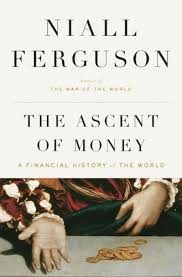The Ascent of Money, by Niall Ferguson
Book 1: The Ascent of Money: A Financial History of the World
What is money, and where did it come from? This is the basic question Ferguson tries to answer in The Ascent of Money. In a broad historical overview of the development of money – and the subsequent creation of loans, cash, and power – Ferguson traces the history of money until the near-present day.
(His historical analysis does not fully include some of the more recent changes in the way we all regularly use money, such as instantaneous banking and money transfers. Paypal, as a prominent example, changed money tremendously by allowing people to transfer money nearly instantly at a fraction of the cost as “regular” banks. To watch the 4 hour documentary with Ferguson, check out this PBS broadcast.)
The Ascent of Money traces the history of money in parallel to the development of civilization, showing how cash is inherently linked to the creation of countries, to the advent and success of wars, to the rise and fall of societies, and to the modern development of banking, finance, and markets.
Ferguson makes the case that countries that have embraced the historic inventions of borrowing and lending, bond and stock markets, insurance, home ownership, and modern financial instruments have done better than countries that have not. Further, he reiterates that capitalism — despite its uncertainties and fluctuations — is the foundation for economic innovation, growth, and stability. Many of the inventions related to money have generated new businesses, growth, and opportunities — much like the modern-day inventions of PayPal and applications related to money transferring.
The wary person may initially view capitalism as potentially destructive, and Ferguson agrees: finance and business are tools of both creation and destruction. In good times in a modern economy, around one in 10 U.S. companies fails every year.
Capitalism, much like biological evolution, uses regeneration as a method for creating better businesses and eliminating weaker institutions in the market. Ferguson’s best point is that finance is evolutionary — that many, many firms fail, and that “creative destruction” and “survival” are hallmarks of any healthy economic system. Failure, in its evolutionary sense, is the elimination of businesses that aren’t stable and won’t survive.
Throughout The Ascent of Money, Ferguson demonstrates that even small government changes in the United States (in interest rates, incentives, and monetary and fiscal policy) have had far-reaching implications across the country. For example, federal policies encouraging home ownership equality for low-income families in the 1990s were one factor in the recent explosion of foreclosures and housing decline. These policies, Ferguson argues, were designed as an incentive to promote accessibility to the “American Dream,” yet failed to account for the inappropriate riskiness of the new loans.
Ferguson’s final argument is against government “meddling,” in which he suggests that the natural business cycle should be allowed to control market forces and influence economic growth. Rather than “rush to stabilize the financial system,” governments should allow recessions and busts to occur, as they are the self-correcting mechanisms of good capitalist economies. Financial history shows again and again that economies and financial models are inherently self-regulating. The recent economic recession should be taken as proof that the system is working.
The positive results of economic growth include job availability; reduced poverty; increased spending on education, art, and the environment; better health care; greater social mobility; and greater tolerance of diversity. Unfortunately, the costs of self-correcting economies are predominantly social: job losses, labor changes, company failures, and relocations, all of which affect the quality of life for the individual. Yet the alternative — excessive regulation and interference — could be more damaging by limiting growth and reducing economic stability. Economic growth — and financial markets — are tools for long-term prosperity, despite cyclical setbacks and uncertainties in the system.
Understanding the importance of promoting economic growth — and reviewing historic policy changes (such as home-ownership loans, insurance regulation, development incentives, and the rules and regulations of banking) — sets the stage for planners to understand the trade-offs inherent in public policy. Ferguson’s conservative arguments may be debatable (as they are some of the core values that differentiate Republicans from Democrats) but his history is fascinating and the case he makes for reduced intervention is solid.
What do we know about money?
Conclusions?
While Ferguson stutters to a start in his long-winded history, The Ascent of Money is worth a read if you skim the first chapters and focus on the later writing. His prescience for understanding the implications of the housing, credit, and financial crises should be applauded; his cautionary lessons in financial policy should be heeded. Skim the rest if you have any time for interesting history.
For part two of this book series, check out the second post – Book Notes (Double Feature!): The Great Inflation and Its Aftermath.
___
These articles are adapted from a longer review written in 2009 for The New Planner, a publication by the American Planning Association.
The Ascent of Money: A Financial History of the World, by Niall Ferguson. Penguin, 2008.
—



